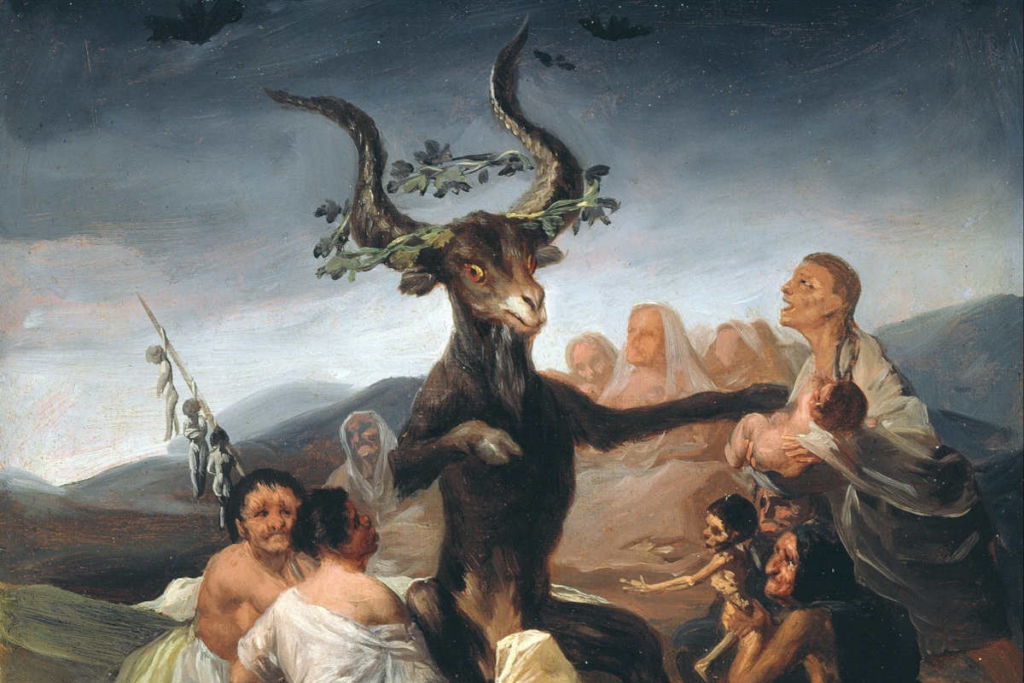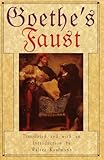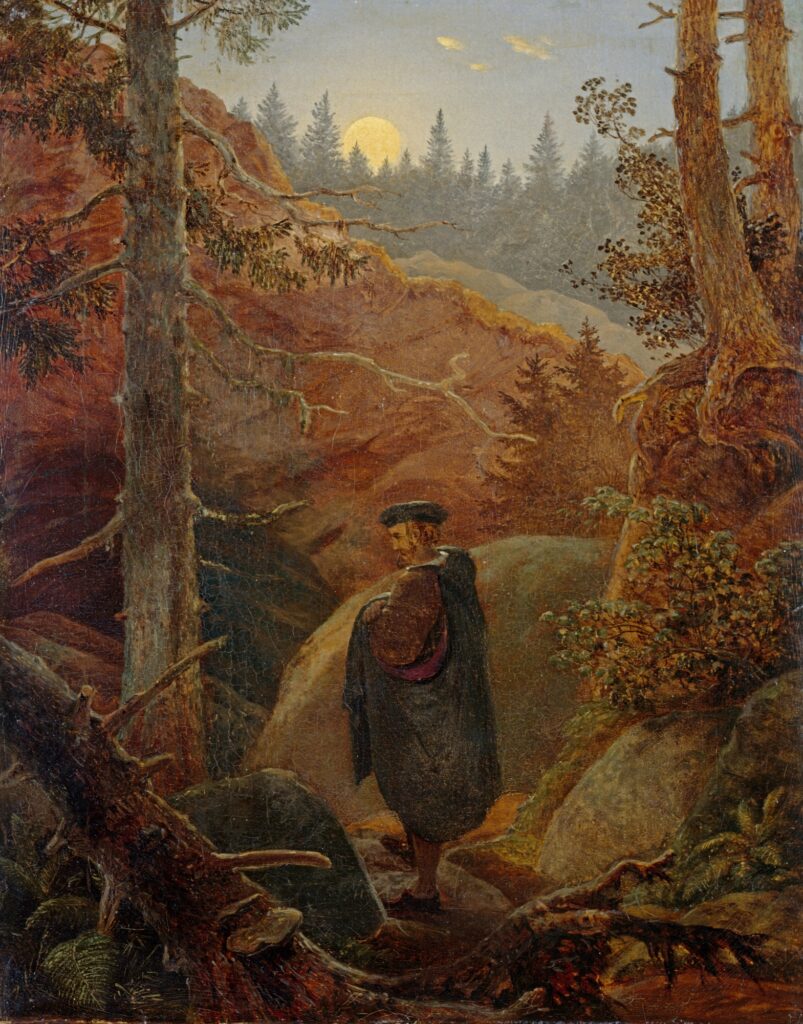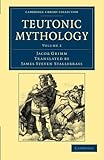A hiker who sets out from the half-timbered German village of Schrierke intending to scale Brocken Mountain—the snow line still visible at the last dusk of April when the clover blooms crimson, the vetch is already blue, and green leaves are again on the elms and sycamores—might experience the “specter” associated with that peak, wherein backscatter sunlight against the fog can cause a person’s shadow to be magnified and projected upon the clouds, conjuring a ghostly, dark doppelgänger. Occasionally, this gargantuan silhouette is accompanied by what the Germans call a Heiligenschein, a halo-like glow about the periphery of the darkness; sometimes, the whipping wind moves the clouds so quickly that these giant penumbras appear as if they’re swiftly creeping along the rocky hillside. An eerie, disquieting, unearthly image, explicable as an optical illusion and yet for centuries an ominous and menacing visage across th/e snow and fog-covered Harz Mountains.
“And art thou nothing?” asked Samuel Taylor Coleridge in a poem of 1828, these visions at “wintry dawn, where o’er the sheep-track’s maze / The viewless snow-mist weaves a glist’ning haze… gliding without tread, / An image with a glory round its head.” For Romantics like Coleridge, the so-called specter was an example of nature’s sublimity, whether experienced in the Scottish Highlands or the Harz, but only the German mountain in that later chain has its name affixed to the phenomenon. That’s because long before the Romantics this peak had certain associations about it. “There is a mountain very high and bare,” writes the linguist and folklorist Jacob Grimm, “whereon it is given out that witches hold their dance.”
 In honor of Walpurgisnacht, as the evening of April 30 is known, the hamlets of Saxony-Anhalt do a brisk spring-time tourist trade selling beer steins decorated with broomstick-riding witches and felt dolls of wizened crones, though the celebration has long had a more solemn purpose. Back when the seasons of the year were as a liturgy—when there still were reliable seasons of the year—Walpurgisnacht was among the “rites focused on driving back darkness and cold in early spring and on rebirth and reopening,” as Ronald Hutton explains in Queens of the Wild: Pagan Goddesses in Christian Europe. Even today, Walpurgisnacht is marked throughout Europe; in Sweden, Finland, Lithuania, and Estonia, Czechia, Slovakia, Slovenia, and Austria, and even as far west as the Netherlands. Regardless of its widespread observance, featuring bonfires and the ringing of church bells from Ljubljana and Stockholm to Amsterdam and Bratislava, Brocken remains the naval where that cosmic umbilical cord connects the material realm to the spiritual. Describing the legends that go back long before Christianity came to the valleys between the Wesser and Elbe Rivers, Grimm writes in his 1835 Teutonic Mythology that at Brocken, “Our forefathers kept the beginning of May as a great festival, and it is still regarded as the trysting time of witches.”
In honor of Walpurgisnacht, as the evening of April 30 is known, the hamlets of Saxony-Anhalt do a brisk spring-time tourist trade selling beer steins decorated with broomstick-riding witches and felt dolls of wizened crones, though the celebration has long had a more solemn purpose. Back when the seasons of the year were as a liturgy—when there still were reliable seasons of the year—Walpurgisnacht was among the “rites focused on driving back darkness and cold in early spring and on rebirth and reopening,” as Ronald Hutton explains in Queens of the Wild: Pagan Goddesses in Christian Europe. Even today, Walpurgisnacht is marked throughout Europe; in Sweden, Finland, Lithuania, and Estonia, Czechia, Slovakia, Slovenia, and Austria, and even as far west as the Netherlands. Regardless of its widespread observance, featuring bonfires and the ringing of church bells from Ljubljana and Stockholm to Amsterdam and Bratislava, Brocken remains the naval where that cosmic umbilical cord connects the material realm to the spiritual. Describing the legends that go back long before Christianity came to the valleys between the Wesser and Elbe Rivers, Grimm writes in his 1835 Teutonic Mythology that at Brocken, “Our forefathers kept the beginning of May as a great festival, and it is still regarded as the trysting time of witches.”
Grimm was probably right that ancient Teutons recognized this astrologically auspicious date (as the Celts did with their celebration of Beltane) for there is a reason why May 1 was made a saint’s day in honor of the eighth-century Anglo-Saxon nun and missionary to the Franks named Saint Walpurga. Patron of those suffering from rabies and whooping cough, Saint Walpurga was most associated with driving witches out of her parish, and as a result she was integral in the Church-sanctioned campaign against witchcraft. Lighting fires and ringing bells were now repurposed against the witches, all on the day before Walpurga is to be honored, when it was understood that supernatural forces were at their strongest during this period of sunny days and chilly nights. With the characteristic irony that attended the often-forced conversion of so-called pagans, it should be mentioned that there was an ancient spring fertility goddess, Walburga, who had once been venerated on this very date. Now, rather than Walburga chasing away the winter, April 30 would be dedicated to Walpurga chasing out the witches. But this day has always been defined by ambiguity and confusion, where it’s easy to mistake your own shadow for a ghost.

Walpurgisnacht—halfway between the vernal equinox and the estival solstice, on the exact opposite side of the year from Halloween—is still a gloaming time when the membrane between the here and the hereafter is more porous, a twilight hour of the calendar when the supernatural can enter our world.  “Walpurgis Night…. when the graves were opened and the dead came forth and walked,” writes Bram Stoker in his less-read 1914 follow-up Dracula’s Guest. “When all evil things of earth and air and water held revel”—and if not evil, then alien, strange, and beautiful. In the transition of winter into spring, as snow melts into the soggy earth and green-fields are dappled in showers, there is a powerful liminality, a sense of the vagaries of nature shifting from freezing to warmth, of the capricious personality of our environment that deigns to let us live amidst it for a time. Of something bigger than us—something deserving of veneration, if not sacrifice.
“Walpurgis Night…. when the graves were opened and the dead came forth and walked,” writes Bram Stoker in his less-read 1914 follow-up Dracula’s Guest. “When all evil things of earth and air and water held revel”—and if not evil, then alien, strange, and beautiful. In the transition of winter into spring, as snow melts into the soggy earth and green-fields are dappled in showers, there is a powerful liminality, a sense of the vagaries of nature shifting from freezing to warmth, of the capricious personality of our environment that deigns to let us live amidst it for a time. Of something bigger than us—something deserving of veneration, if not sacrifice.
Because Brocken is nearly 4,000 feet tall, and thus closer to Asgard, or the astral realm, or heaven, or what-have-you, there is an intuitive sense that it would be the place where spirits should return as the light follows that darkest of midnights. Location alone isn’t what has solidified the mountain in the imagination as the meeting place of Walpurgisnacht covens, however, for both the peak and the holiday have appeared in poetry and prose by Heinrich Heine, Mikhail Bulgakov, Thomas Mann, and so on. But if Brocken endures with infernal associations, it’s in large part due to Johann Wolfgang von Goethe.
 “We, it seems, have entered newly / In the sphere of dreams enchanted,” says the notorious necromancer Dr. Faust to the demon Mephistopheles; the latter has sold his soul to the former in exchange for the full power and depth of experience. As I explain in my new book, Devil’s Contract: The History of the Faustian Bargain, Goethe’s closet drama “fuses the micro and the micro, the cosmological and the quantum, into a single unity […] much more is at stake than the soul of a mere man. For Goethe’s Faust, the ultimate purpose isn’t to elevate himself above our physical world, but rather to fuse with it, to become its incomparable master,” to espy the kingdoms of this planet from that highest peak.
“We, it seems, have entered newly / In the sphere of dreams enchanted,” says the notorious necromancer Dr. Faust to the demon Mephistopheles; the latter has sold his soul to the former in exchange for the full power and depth of experience. As I explain in my new book, Devil’s Contract: The History of the Faustian Bargain, Goethe’s closet drama “fuses the micro and the micro, the cosmological and the quantum, into a single unity […] much more is at stake than the soul of a mere man. For Goethe’s Faust, the ultimate purpose isn’t to elevate himself above our physical world, but rather to fuse with it, to become its incomparable master,” to espy the kingdoms of this planet from that highest peak.
 Published in two parts in 1808 and 1832, respectively, Goethe’s Faust is the consummate work of German Romanticism, and by far the most influential telling of the notorious legend in which a soul is bartered to the Devil. In “Part One” of Goethe’s poem, Mephistopheles takes his charge to “the vast, desert places,” the peak of Brocken on Walpurgisnacht. On their ascent up the mountain, the two encounter a variety of Satan’s penitents, culminating in a coven of witches that includes the ancient Canaanite Succubae Lilith, Adam’s first wife. Faust licentiously dances with the beautiful demoness, all while pining for his beloved, but tragically dead, Gretchen. For a minute Faust thinks he sees Gretchen among the worshipers, only to learn that this is another cruel trick of illusion as fanciful as the will-o’-the-wisps which led him to the peak. A peak of heartbreak and tragedy, but paradoxically also of regeneration and even creation, where flux and chaos have their own potential, even if such possibilities are largely depicted as ominous.
Published in two parts in 1808 and 1832, respectively, Goethe’s Faust is the consummate work of German Romanticism, and by far the most influential telling of the notorious legend in which a soul is bartered to the Devil. In “Part One” of Goethe’s poem, Mephistopheles takes his charge to “the vast, desert places,” the peak of Brocken on Walpurgisnacht. On their ascent up the mountain, the two encounter a variety of Satan’s penitents, culminating in a coven of witches that includes the ancient Canaanite Succubae Lilith, Adam’s first wife. Faust licentiously dances with the beautiful demoness, all while pining for his beloved, but tragically dead, Gretchen. For a minute Faust thinks he sees Gretchen among the worshipers, only to learn that this is another cruel trick of illusion as fanciful as the will-o’-the-wisps which led him to the peak. A peak of heartbreak and tragedy, but paradoxically also of regeneration and even creation, where flux and chaos have their own potential, even if such possibilities are largely depicted as ominous.

“Tell me, if we still are standing, / Or if further we’re ascending?” Faust asks Mephistopheles, for “All is turning, whirling, blending, / Trees and rocks with grinning faces, / Wandering lights that spin in mazes, / Still increasing and expanding!” For all of that dialogue with his demon, then, there is a remarkable painting of 1828 by Carl Gustav Carus, rendered two decades after his friend Goethe finished the first part of Faust and four before he completed the second, in which he imagines the eponymous wizard setting out on his hike up Brocken. Faust in the Mountains, now displayed at the Staatliche Kunstsammlungen in Dresden, depicts its subject in a wizardly green robe and Renaissance cap, looking forlornly toward the craggy earth as he begins to make his way through the forest just starting to bloom, a murderous pink moon rising over the distant green pine trees on the midnight horizon. Most remarkable is what Carus has deigned to not depict: Mephistopheles. This Faust is on a lonely sojourn, raising a possibility that like the specters named for Brocken, all of his associates—Mephistopheles, Lilith, the witches—are but figments of the mind, a far more terrifying place than anything to be found upon the mountain.
Walpurgisnacht is virtually unknown in the United States; this is unfortunate, and not just because spring deserves its own Halloween. In a culture permeated with violence but in denial about it, in a culture where all manners of evil exit—casual cruelty, rank oppression, ecological devastation—any reminder of the demons of this fallen world is important. But Walpurgisnacht was never just about witches’ covens and Black Masses, or about rightly genuflecting before unconquerable darkness lest it extinguish the light. The holiday also concerns the occult power of creation, of being able to conjure chimeras out of the ether, of visions from the chaos. Winifried Hodge Rose writes in her essay “Walburga and the Rites of May” that this is a “time for looking into that which is coming into being and which should be, for seeking deep roots of life-knowledge and life-mysteries, for love-magic and spells of growth and change, conception and birth.”
 In the permeable dusk of Walpurgisnacht, these are powerful forces, a reminder that creation and imagination need not be the preserve of an elite, of a priesthood of artists and writers and musicians, but that they are a birthright to all humanity. Creation and imagination—to see that which is normally invisible, to conceive of that which does not yet exist—is the most potent spell, the most powerful form of resistance. It’s no wonder inquisitions were launched against witches—and, in turn, against women, against nature, against the vital spark of self-creation. As Silvia Federici writes in Witches, Witch-Hunting, and Women, “the witch hunt stands at a crossroad of a cluster of social processes that paved the way for the rise of the modern capitalist worlds.” So then, against the Church and its missionaries, as well as capitalism and its industrialists, Walpurgisnacht can remain as a tool of revolution, true to that word’s implication of a returning.
In the permeable dusk of Walpurgisnacht, these are powerful forces, a reminder that creation and imagination need not be the preserve of an elite, of a priesthood of artists and writers and musicians, but that they are a birthright to all humanity. Creation and imagination—to see that which is normally invisible, to conceive of that which does not yet exist—is the most potent spell, the most powerful form of resistance. It’s no wonder inquisitions were launched against witches—and, in turn, against women, against nature, against the vital spark of self-creation. As Silvia Federici writes in Witches, Witch-Hunting, and Women, “the witch hunt stands at a crossroad of a cluster of social processes that paved the way for the rise of the modern capitalist worlds.” So then, against the Church and its missionaries, as well as capitalism and its industrialists, Walpurgisnacht can remain as a tool of revolution, true to that word’s implication of a returning.
Incidentally, Faust wasn’t the first time that Goethe ruminated on April 30. His 1799 ballad “The First Walpurgisnacht” (later set to music by Felix Mendelsohn) conceives of this witches’ carnival in an entirely a more liberatory manner than he does in Faustus. A synod of Druids assemble atop Brocken on what’s the eve of the first celebration, and thus also of Christianity’s dominance over the supernatural realm. For the druids, this is not an issue of worshiping the Devil, but of reverencing “Sweet smiles the May! / The forest gay / From frost and ice is freed; / No show is now, / Glad sounds resound / Across the verdant mead.” As these people have done for centuries immemorial, they have honored the arrival of spring on this day, but now with the arrival of Christianity, with the staidness of Walpurga’s rituals and relics, women and men are to be separated from the earth, from the seasons and their cycles. This was a tragedy. It continues to be a tragedy.
And yet as the cool of the pagans’ April 30 evening should turn into the dawn of the Christians’ May 1, with the eyelids of morning raising upon this newer, lesser enchanted world, the druids promise that Walpurga shall not have wholly exorcized her sister Walburga. “As from the smoke is free the blaze, / So let our faith burn bright!” concludes a chorus of druids, “And if they crush our olden ways, / Whoe’er can crush Thy light?”

